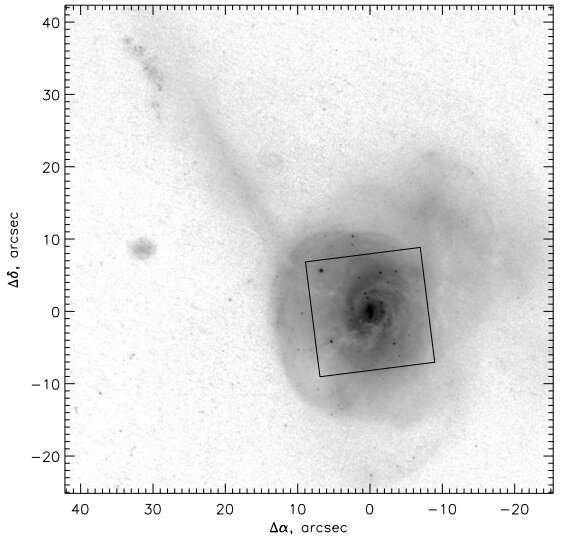F435W-band HST image of Mkn 938 obtained with ASC camera. Credit: Afanasiev et al., 2020.
Using the 6-meter telescope of the Special Astrophysical Observatory of the Russian Academy of Sciences (SAO RAS), astronomers have conducted a detailed study of the central part of the galaxy Mkn 938. Results of the research shed more light on internal kinematics of this galaxy. The study was presented in a paper published February 25 on the arXiv pre-print server.
Located some 278 million light years away, Mkn 938 is an interacting Seyfert type II galaxy with a peculiar morphology and active nucleus. Observations suggest that Mkn 938 is most likely a result of a merger of two gas-rich galaxies. It is assumed the galaxy is currently in the final stage of this interaction, hence it experiences an extremely powerful burst of star formation and nuclear activity.
Studies of merging gas-rich galaxies like Mkn 938 could deliver important insights about the formation evolution of galaxies in general. Astronomers are particularly interested in how a gas-rich system gets rid of gas, and how this process is affected by a burst of star formation at the center and the presence of active nucleus.
So a team of Russian researchers led by Victor Afanasiev of SAO RAS performed 3-D spectroscopy of the central region of Mkn 938. For this purpose, they used the integral-field spectrograph MPFS and the scanning Fabry–Perot interferometer on the 6-meter telescope of SAO.
"We observed Mkn 938 in the optical with the 6-m telescope of the Special Astrophysical Observatory of the Russian Academy of Sciences (SAO RAS) within the framework of a program of spectrophotometry of Seyfert galaxies," the astronomers wrote in the paper.
The observations revealed many peculiarities of the stellar and gas kinematics in Mkn 938. In particular, the study mapped the high-velocity galactic wind on large spatial scale in Mkn 938 and detected gas outflow in the circumnuclear region of this galaxy.
The galactic wind in the Na D absorption line was mapped for the first time in Mkn 938. The spectrum of the central part of the galaxy exhibits a broad Na D, absorption line blueshifted by 620 km/s relative to the systemic velocity of 5,880 km/s. The astronomers noted that this spectral line is observed in many ultra-bright infrared active starburst galaxies.
An ionized gas outflow in Mkn 938 have been observed with velocity of at least 400 km/s. The researchers explained that similar outflows can also be observed in starburst galaxies, however the relatively high outflow velocity in Mkn 938 can be explained only by the influence of the active nucleus.
The authors of the paper concluded that the results provide important insights into internal kinematics of Mkn 938.
"All this together can be interpreted either as the ionized component of galactic wind mapped in Na D, or as the effect of the jet emerging from the active nucleus on the interstellar medium. Unfortunately, no jet has so far been detected in radio observations of Mkn 938," the researchers wrote.
More information: Internal Kinematics of the Seyfert Galaxy Mkn 938, arXiv:2002.10812 [astro-ph.GA] arxiv.org/abs/2002.10812
© 2020 Science X Network
























